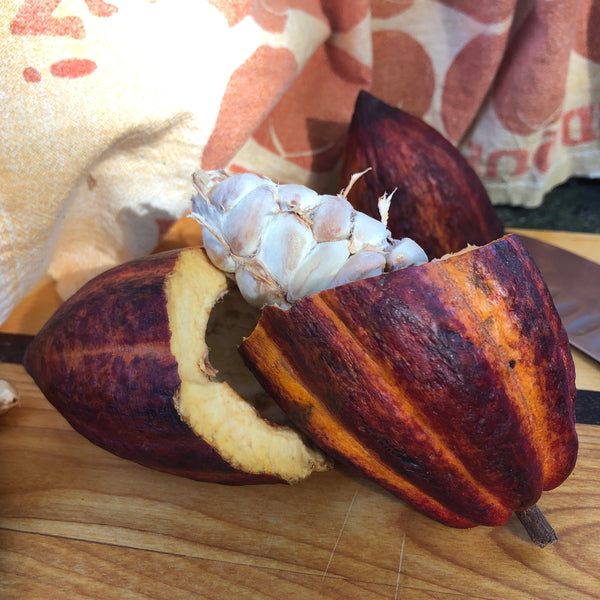The Life Cycle of a Cacao Pod
Sep 01, 2022
Here in early September in Massachusetts, fall is coming…but it’s not quite here. We’re harvesting our tomatoes, enjoying for a bit longer the night sounds of crickets and katydids, luxuriating in a cool evening swim, and anticipating nature’s annual glorious show of color in our New England forests.
What’s going on in Guatemala, the home of our cacao beans? It’s also a season of anticipation as farmers prepare for the biggest harvest of the year, which will start next month. Interested in the full cycle of a cacao pod? Keep reading.
Cacao trees are a perennial crop, meaning they blossom and produce fruit throughout the year. We call their fruit cacao pods; the seeds within the pod are the primary ingredient of chocolate. I’m not sure why we call these seeds beans instead of just seeds, but it may be because, in their natural state, the seeds resemble big lima beans.
Like any other fruit tree, each cacao pod starts with a small flower. Unlike the fruit trees we are most familiar with, though, the cacao flowers sprout directly from the tree trunk and thick branches, not just from the slender ends of branches. Flowers are pollinated by tiny flies called midges. A side note is that these fragile insects are threatened by climate change, so there is a fair amount of research going on to solve this problem. To manually increase the yield of a given tree, or when there are no midges present, it is possible for farmers to hand pollinate during the flowering stage of the crop. Smith College’s Botanic Garden staff hand pollinates their cacao tree, for example.
Though one given tree may have an abundance of flowers, it is estimated that fewer than ten percent will ultimately produce a harvestable pod. Around six months after the first appearance of a flower, if that flower is one of the lucky few, it will have been replaced by a mature cacao pod.
While pods can form at any time during the year, the two main harvests are between May-July (during the rainy season) and October-March (during the dry season). The harvest during the dry season usually offers the highest yields. The smaller rainy season harvest, while still essential to consistent export of beans, runs a greater risk of disease and fungus growth on the pods due to the high humidity.
You may not want to leave New England’s natural beauty and perfect weather at this time of year, but if you’re tempted, this is a great time to visit Guatemala. If you’re trekking in the mountains, you’ll likely have blue skies above and dry ground below your feet. The coasts will be hotter and more humid, but the sea breeze will compensate. And if you’re lucky, maybe you can visit a cacao farm and witness a harvest.
Sources:http://apps.worldagroforestry.org/treesandmarkets/inaforesta/documents/agrof_cons_biodiv/cocoa%20frm%20bud%20to%20bean.htm#:~:text=Less%20than%2010%20per%20cent,grow%20into%20a%20mature%20fruit.
https://www.uncommoncacao.com/blog/2018/4/4/origin-report-cahabn-guatemala

